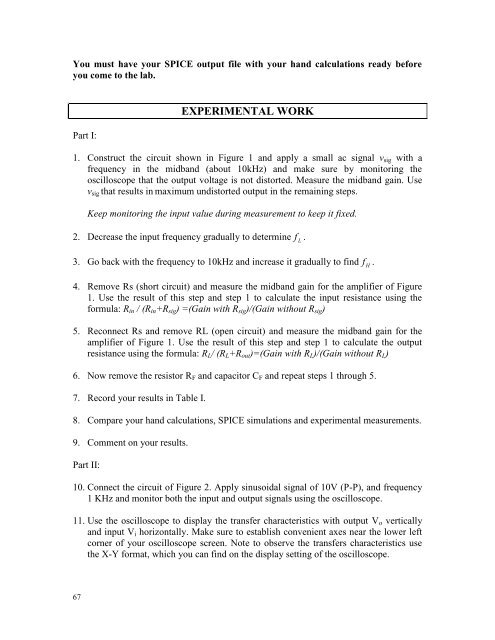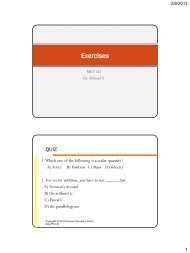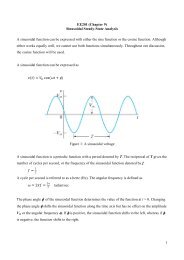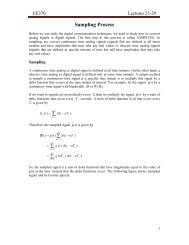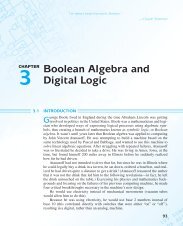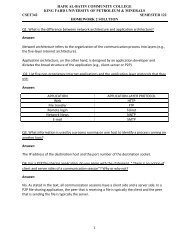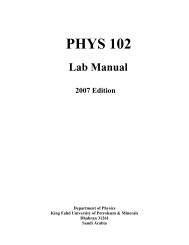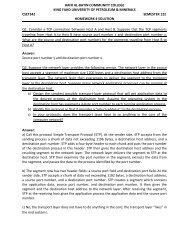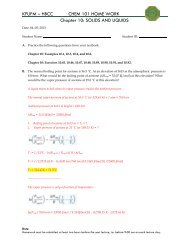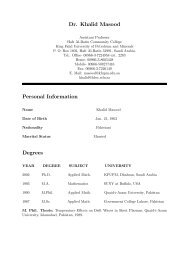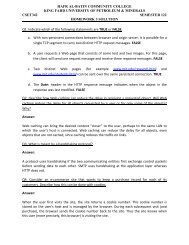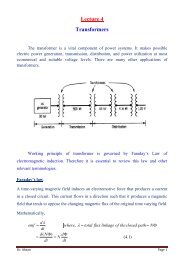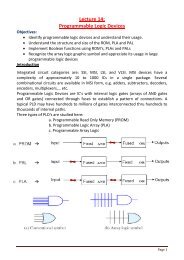Laboratory Manual - King Fahd University of Petroleum and Minerals
Laboratory Manual - King Fahd University of Petroleum and Minerals
Laboratory Manual - King Fahd University of Petroleum and Minerals
You also want an ePaper? Increase the reach of your titles
YUMPU automatically turns print PDFs into web optimized ePapers that Google loves.
You must have your SPICE output file with your h<strong>and</strong> calculations ready before<br />
you come to the lab.<br />
Part I:<br />
EXPERIMENTAL WORK<br />
1. Construct the circuit shown in Figure 1 <strong>and</strong> apply a small ac signal v sig with a<br />
frequency in the midb<strong>and</strong> (about 10kHz) <strong>and</strong> make sure by monitoring the<br />
oscilloscope that the output voltage is not distorted. Measure the midb<strong>and</strong> gain. Use<br />
v sig that results in maximum undistorted output in the remaining steps.<br />
Keep monitoring the input value during measurement to keep it fixed.<br />
2. Decrease the input frequency gradually to determine f L<br />
.<br />
3. Go back with the frequency to 10kHz <strong>and</strong> increase it gradually to find f H<br />
.<br />
4. Remove Rs (short circuit) <strong>and</strong> measure the midb<strong>and</strong> gain for the amplifier <strong>of</strong> Figure<br />
1. Use the result <strong>of</strong> this step <strong>and</strong> step 1 to calculate the input resistance using the<br />
formula: R in / (R in +R sig ) =(Gain with R sig )/(Gain without R sig )<br />
5. Reconnect Rs <strong>and</strong> remove RL (open circuit) <strong>and</strong> measure the midb<strong>and</strong> gain for the<br />
amplifier <strong>of</strong> Figure 1. Use the result <strong>of</strong> this step <strong>and</strong> step 1 to calculate the output<br />
resistance using the formula: R L / (R L +R out )=(Gain with R L )/(Gain without R L )<br />
6. Now remove the resistor R F <strong>and</strong> capacitor C F <strong>and</strong> repeat steps 1 through 5.<br />
7. Record your results in Table I.<br />
8. Compare your h<strong>and</strong> calculations, SPICE simulations <strong>and</strong> experimental measurements.<br />
9. Comment on your results.<br />
Part II:<br />
10. Connect the circuit <strong>of</strong> Figure 2. Apply sinusoidal signal <strong>of</strong> 10V (P-P), <strong>and</strong> frequency<br />
1 KHz <strong>and</strong> monitor both the input <strong>and</strong> output signals using the oscilloscope.<br />
11. Use the oscilloscope to display the transfer characteristics with output V o vertically<br />
<strong>and</strong> input V i horizontally. Make sure to establish convenient axes near the lower left<br />
corner <strong>of</strong> your oscilloscope screen. Note to observe the transfers characteristics use<br />
the X-Y format, which you can find on the display setting <strong>of</strong> the oscilloscope.<br />
67


